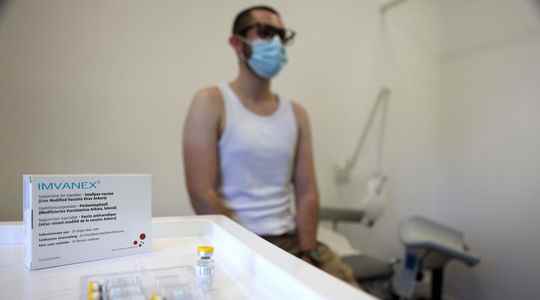A smaller sting for a bigger effect… and bigger irritations? The European Medicines Agency (EMA) authorized, on Friday August 19, a new technique for injecting the vaccine against monkeypox. It promises to immunize more people with a lower dose, and thus prevent a possible shortage. At the risk of seeing more vaccinated people contract lesions because of the bite. Explanations.
In France, 2,889 cases of monkeypox have been identified since the start of the epidemic. This disease, previously limited to Central and West Africa and which causes significant and painful skin rashes, is progressing almost everywhere in Europe. To limit the spread of the epidemic, the European health authorities have authorized the use of an already proven vaccine for smallpox, called Imvanex.
Due to the similarity of the two viruses, they approved the extension of the use of Imvanex on July 22, specifying that the injection must be subcutaneous, therefore deep. This decision triggered a global rush for this vaccine, now the only authorized against this disease. In France alone, more than 1.5 million doses have recently been ordered, according to the JDD. The serum is effective, but its supply remains “limited”, recognizes for its part theEMA.
“Limited” doses
Faced with this lack of resources, and to avoid unnecessary vaccination, most national health authorities have defined a target audience (men who have sex with men, with multiple partners, or sex workers) in whom it is urgent to offer the monkeypox vaccine, rather than making it available to everyone. According to the latest US data, 98% of cases involve men, and 93% of men say they have had sexual contact with other men.
In France, “more than 30,000” people have already received a dose, Health Minister François Braun said last week. The pace is increasing but remains too low in the eyes of LGBT + associations, while nearly 40% of cases are subject to complications, according to a study published in the scientific journal The Lancet. A fifth of the patients detected were also hospitalized, according to another analysis published in the journal NEJM.
Last week, the French associations therefore called for a step up. “At the current rate, all eligible people” will be vaccinated only “at the end of December, and with a single dose”, declared in a joint press release, Act-Up Paris, AIDES, Sidaction and the union of sex workers STRASS. Monkeypox is not very lethal but painful, and its effects are not all known.
To avoid the shortage, European countries can now administer the Imvanex vaccine just under the upper layer of the skin (intradermally) and no longer deep (subcutaneously), as is currently the case. This technique uses a lower dose of vaccine and produces the same immunity, for only a fifth of the dose. This method has been authorized in the United States since August 9, when the country considers the epidemic a public health emergency.
Less serum, more skin problems
European Commissioner Stella Kyriakides stressed on Friday that this authorization was an “extremely important decision because it makes it possible to vaccinate five times more people with the stocks of vaccines we currently have”. “This ensures better access to vaccination for people at risk and healthcare professionals,” she added in a statement.
To affirm this, the institution bases itself on a clinical trial involving approximately 500 adults and comparing the two types of injection. “People receiving the vaccine intradermally received one-fifth (0.1ml) of the dose subcutaneously (0.5ml) but produced similar antibody levels as people who received the subcutaneous dose. higher skin level,” explained the EMA. However, this technique has a major drawback: with intradermal injection, the risk of skin irritation is “higher”, warned the monitoring body based in Amsterdam (Netherlands).
In the clinical trial conducted in 2015, people who received the currently authorized intradermal injection were twice as likely to experience moderate to severe local reactions, and 1.6 times as likely to experience redness and hardening of the skin at the sting. Some adverse effects are long-lasting: 30% of patients who have benefited from the new technique have discoloration of the skin at the injection site for more than 6 months. Pending increased availability of doses, the authorities have therefore deemed that the vaccine always brings more benefits than risks, while monkeypox can leave large craters all over the body. Even lead to death.
